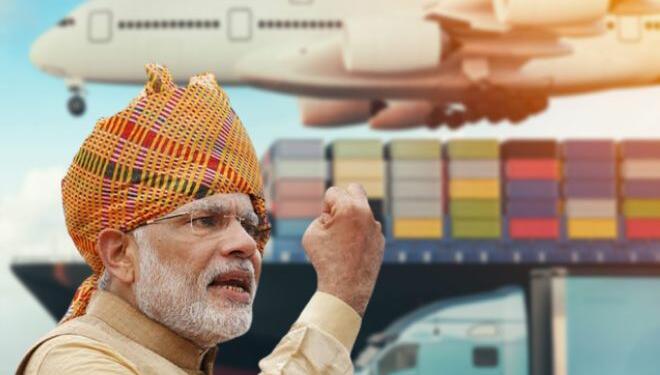India’s exports sector is getting bullish and is reaching higher levels. Amiya Chandra, Additional DGFT (Directorate General of Foreign Trade), has disclosed an exports target of $500 billion for 2022-23 fiscal. India is benefitting from changing trends in international trade. Europe and the US are no longer the fulcra of international trade. Rather, the centre of global trade has shifted eastward to Southeast Asia, a region closer to India.
India records highest-ever exports in December 2021
Addressing the Bengal Chamber of Commerce and Industry, Chandra said that exports stood at $37.8 billion in December 2021. This is the highest level that exports have touched in any one month.
Chandra added, “We are bang on target to touch $400 billion for the current fiscal. So far in the first nine months, the country’s exports were to the tune of $301.38 billion.” He also said that the country is targeting $1 trillion exports by 2027.
Exports register around 50% jump
Indian exports have grown rapidly in the ongoing fiscal. Between April and December, exports went up by 49.66 per cent.
Chandra said, “The apprehension that COVID-19 would lead to a sharp decline in foreign trade has turned out to be negative. However, the pandemic has taught us to reimagine world trade.”
Reimagining world trade- focusing on bilateral FTAs
India has started to “reimagine world trade”. It has been understood that world trade is no longer driven by the West but the Indo-Pacific in general and Southeast Asia in particular. Therefore, India plans on using its position as the gateway to the Indo-Pacific and ASEAN countries to ramp up its export sector.
The country also benefits from changing global supply chains and a shift away from multilateral free trade agreements (FTAs). As per Chandra, multilateral trade agreements are now being replaced by bilateral ones and India is already in the process of entering into six FTAs.
India’s experience with FTAs hasn’t been good in the past. Lack of regulatory and institutional safeguards in such FTAs have affected India’s domestic industries in the past. This is why India has maintained a safe distance from initiatives like the Regional Comprehensive Economic Partnership (RCEP).
This is why bilateral FTAs make much more sense for India. It allows the room and the flexibility to negotiate every contentious clause with the other party and to ensure that New Delhi’s concerns do not go unaddressed.
Union Commerce and Industry Minister Piyush Goyal too has said that India is not signing FTAs just to be part of a group. The Minister said, “We are looking at robust FTAs with like-minded nations with values of democracy, transparency and mutual growth.” Goyal also said, “Our focus is wherever we have a comparative or competitive advantage, we should look at market access and wherever the advantage is with some other country, we don’t have to force the Indian consumer to buy expensive.”
The present era has a lot to offer for India in terms of trade- both geographically and strategically. India doesn’t want to miss the bus. It is renegotiating the rules of bilateral trade with its partners to truly unlock the potential of its exports economy to establish itself as a huge trade giant.































